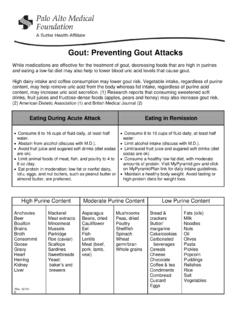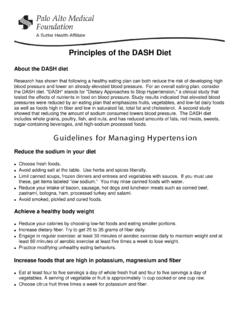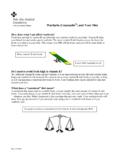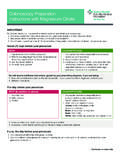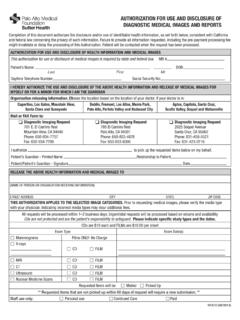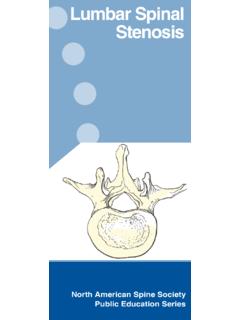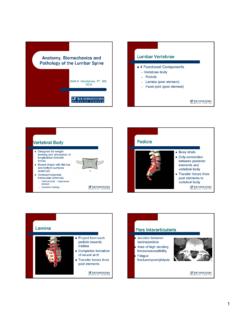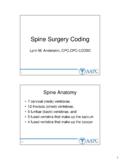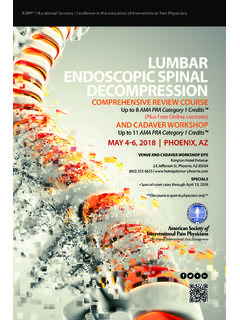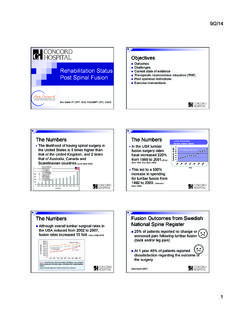Transcription of Pars Stress Fractures of the Lumbar Spine
1 Pars Stress Fractures of the Lumbar Spine By Sally S. Harris, , MPH How can an athlete tell if she or he might be developing a pars Stress fracture? A pars Stress fracture usually causes low back pain that is predominantly on one side of the back, as opposed to in the center of the back. It is caused by overuse and usually starts as mild pain that gradually worsens with running, jumping and kicking activities. It is usually felt most while arching backward, rotating at the waist or straightening up from bending forward. Pain typically gets worse with sports and better with rest. Many athletes will try a few days or weeks of rest, during which time the pain will improve, but the pain usually worsens again when the athlete resumes sports. How can you prevent getting a pars Stress fracture? There are many things young athletes can do to avoid getting a pars Stress fracture, these include: Maintaining good physical conditioning during the off season and easing into new sports seasons gradually.
2 Increasing hours of participation in sports gradually. Increasing high impact activities (running and jumping) or activities that require rotation and arching of the back (pitching, serving, spiking, blocking) gradually. Taking at least one day off from sports per week, and ideally several weeks off every several months. Avoiding year round participation or participating on more than one team in the same sport at the same time. Maintaining good flexibility in hamstrings and hip flexors, and good strength in the abdominal, Lumbar and core muscles. Stress Fractures often develop during long weekend tournaments, week-long camps focusing on a single sport or during weeks of two daily practices. If back pain persists beyond 2 weeks, athletes should rest and seek medical evaluation. What does the term Stress fracture mean? A Stress fracture, like other Fractures , is a break in the bone.
3 It is referred to as a Stress fracture because it develops as a result of repetitive Stress and overuse associated with sports participation, rather than from a specific acute event or injury. A Stress fracture starts as a weak zone in the bone, called a Stress reaction, then progresses to a partial fracture in the outer surface of the bone, called a Stress fracture. It can then progress to a complete fracture through the bone. What is a pars Stress fracture, how does it develop, and what bone is involved? This condition is the most common cause of low back pain in adolescent athletes. Pars Stress Fractures involve a small connecting bone in the Lumbar Spine , called the pars interarticularis. The pars bone is a small bone that connects the facet joints that are a chain of joints found on each side of the Spine . The facet joints spread apart and have no pressure on them when you are sitting or bending forward, but they press against each other and are under pressure during activities such as running, jumping, kicking, rotating or arching backward.
4 During sports, due to the repetition of these activities, pressure is exerted on the facet joints and this Stress is transmitted to the pars bone, which connects the facet joints. The pars bone is a small bone, that is elongating during adolescent growth, so it is particularly thin and weak and uniquely prone to injury during adolescence. As a result, pars Stress Fractures only occur among adolescents. Most pars Stress Fractures occur at the lowest part of the Lumbar Spine , usually at the Lumbar five level, but may occur at other levels. The pars Stress fracture usually develops first on one side, but will develop on the other side if it is not treated early. Once Stress Fractures develop on both sides, the healing rate is much lower and can lead to permanent pars defects that won t heal. How is a pars Stress fracture diagnosed? These Stress Fractures are not visible on X-rays of the Spine until they have been present for many months.
5 By the time they can be seen on X-rays, they do not have the ability to heal. Most athletes seek medical evaluation because of significant pain at a point before the Stress fracture is visible on an X-ray. The Stress fracture can be diagnosed with an MRI, CT or bone scan. Will imaging studies be done after treatment to evaluate healing? Imaging studies are not usually repeated to evaluate healing. Indications of healing of a pars Stress fracture on imaging studies develop very gradually. Most athletes are able to return to sports long before imaging studies show resolution of the problem, so imaging studies are not useful in determining when the athlete can resume participation. Will this condition lead to permanent problems with my back in the future? When pars Stress Fractures are detected and treated early, boney healing can occur and the problem can resolve completely without increasing the risk of future back problems.
6 However, pars Stress Fractures that fail to heal can progress to permanent pars defects on both sides, called spondylolysis. When this occurs, it can allow the Spine below the level of the defects to slip backwards over time, leading to a condition called spondylolisthesis. This condition significantly increases the likelihood of degenerative back conditions in adulthood, such as disc herniation and nerve impingement. This progression of back problems can be prevented by early diagnosis and proper treatment of pars Stress Fractures . Is there any other treatment besides rest that can speed up healing? Since a pars Stress fracture is a break in the bone, only rest and time promote healing. Healing can be delayed or prevented if the athlete does not rest appropriately. Use of ice or heat, and other external treatments, such as ultrasound, electrical stimulation, acupuncture and massage or chiropractic treatment have no healing benefit.
7 There are no stretching or strengthening exercises that can be done to speed healing. These may actually impede healing, as rest is the most important part of treatment. After about a month of rest, exercises under the direction of a physical therapist will help improve strength and flexibility to reduce the risk of recurrence, but the exercises will not speed up the healing process. Pain medication should be used carefully. Non steroidal anti-inflammatory medications (NSAIDs) like ibuprofen (Advil, Motrin) and naproxen (Aleve) actually slow bone healing. Acetoaminophen (Tylenol) does not affect bone healing, and can be used if needed for pain. However, if the athlete needs medication for pain, this indicates that she or he is not resting enough. In addition, the athlete should avoid taking pain medication because it can mask mild pain that should be a signal to the athlete to rest further and avoid activities or movements causing pain.
8 How long does it take for a pars Stress fracture to heal and when can I return to my sport? A pars Stress fracture, like other Fractures , represents a break in the bone. Although treatment does not usually require a brace or cast, it does require significant rest and time to heal. Typical treatment involves a minimum of two months rest from all high impact activities (running and jumping sports) and any other activities that involve repetitive arching or rotation of the back. There are three phases of treatment, each lasting about a month for most athletes. Most athletes are able to return to full participation in their sport after about 3 months. What are the three phases of treatment and what activities are allowed? Phase 1 (First Month) As soon as the diagnosis of pars Stress fracture is considered, even if not yet confirmed by imaging studies, the athlete should stop all exercise and begin resting.
9 The goal is to avoid anything that causes back pain, because painful movement will impede healing and contributes to progression of the Stress fracture. Once the athlete begins resting from exercise activities, pain felt during routine daily activities (such as standing, walking and changing positions) should resolve within 3 weeks. If this is not the case, the athlete is not resting enough or a back brace may be needed. At the end of the first month the athlete should be reevaluated by their physician. If there has been no pain during daily activities and testing during the physical exam, the athlete is ready to begin the next phase of treatment. Phase 2 (Second Month) The athlete should begin formal physical therapy with a therapist experienced in the treatment of this condition. Since this condition is unique to adolescent athletes, not all therapists are familiar with it.
10 A typical course of physical therapy involves going to physical therapy twice per week for 4 weeks and also doing a home exercise program outlined by the physical therapist. The exercises usually involve Lumbar stabilization and core strengthening exercises. Improving the strength and flexibility of other muscle groups of the hip and legs are also important to decrease Stress on the low back. Many adolescents lose flexibility during a period of rapid growth. Low-impact activities can be introduced during this time, if not associated with pain. High-impact activities and activities that involve repetitive extension or rotation of the back should still be avoided. Some low-impact sport specific skills may be considered during this time, if not associated with pain. The athlete is ready for the next phase of treatment if she or he can successfully complete the physical therapy without pain reoccurring.
